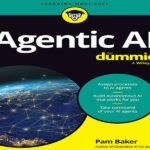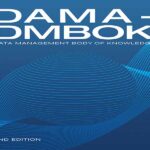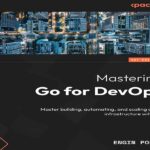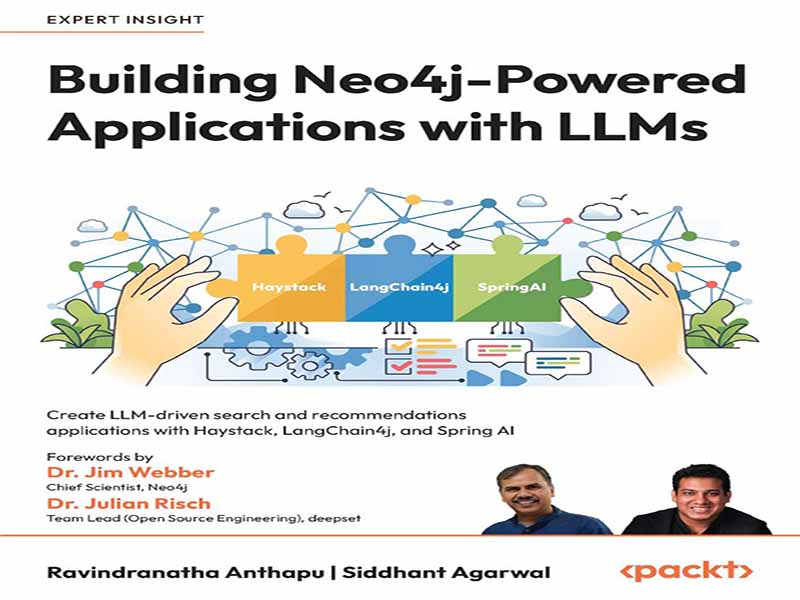- عنوان کتاب: Building Neo4j-Powered Applications with LLMs -Create LLM-driven search and recommendations applications with Haystack, LangChain4j, and Spring AI
- نویسنده: Ravindranatha Anthapu, Siddhant Agarwal
- حوزه: توسعه گراف, Neo4j
- سال انتشار: 2025
- تعداد صفحه: 312
- زبان اصلی: انگلیسی
- نوع فایل: pdf
- حجم فایل: 5.93 مگابایت
ما در حال گذر از یک انقلاب GenAI هستیم – جایی که هوش مصنوعی دیگر فقط یک جزء پشتیبان نیست، بلکه یک کمک خلبان، تولیدکننده محتوا و تصمیمگیرنده است. و با این حال، بسیاری از برنامههای GenAI هنوز با توهم، عدم درک زمینهای و استدلال مبهم دست و پنجه نرم میکنند. اینجاست که این کتاب وارد میشود. این کتاب از یک باور اصلی زاده شده است: نمودارهای دانش حلقه گمشده بین قدرت GenAI و هوش دنیای واقعی هستند. با ترکیب نقاط قوت مدلهای زبان بزرگ (LLM) با دادههای ساختاریافته و متصل Neo4j و تقویت آنها با گردشهای کاری بازیابی-تقویتشده (RAG)، میتوانیم سیستمهایی بسازیم که نه تنها هوشمند، بلکه مبتنی بر زمینه، زمینهای و شفاف نیز هستند. ما این کتاب را نوشتیم زیرا چند سال گذشته را صرف ساخت و نمایش برنامههای هوشمندی کردهایم که بسیار فراتر از موارد استفاده اولیه چتباتها هستند. از توسعه موتورهای توصیه مبتنی بر هوش مصنوعی گرفته تا ادغام چارچوبهایی مانند Haystack، LangChain4j و Spring AI با Neo4j، نیاز روزافزونی به یک راهنمای عملی و کاربردی مشاهده کردیم که مفاهیم GenAI را با معماریهای گراف دانش آماده برای تولید پیوند دهد. چشمانداز این کتاب، تجهیز توسعهدهندگان، معماران و علاقهمندان به هوش مصنوعی به ابزارها، مفاهیم و مثالهای دنیای واقعی مورد نیاز برای طراحی سیستمهای جستجو و توصیهای است که قابل توضیح، دقیق و مقیاسپذیر باشند. شما فقط در مورد LLMها یا گرافها به صورت جداگانه یاد نخواهید گرفت – شما برنامههای کاربردی سرتاسری خواهید ساخت که این فناوریها را در پلتفرمهای ابری، جستجوی برداری، استدلال گراف و موارد دیگر گرد هم میآورند. با مطالعه فصلها، از درک مفاهیم بنیادی به پیادهسازی تکنیکهای پیشرفتهای مانند بازیابی مبتنی بر جاسازی، استدلال گراف و استقرار GenAI بومی ابر با استفاده از Google Cloud، AuraDB و ابزارهای متنباز خواهید رسید. چه مهندس داده باشید، چه توسعهدهنده هوش مصنوعی، یا صرفاً کسی که در مورد آینده سیستمهای هوشمند کنجکاو است، این کتاب به شما کمک میکند تا برنامههایی بسازید که نه تنها هوشمندانهتر هستند، بلکه پاسخهای بهتری نیز تولید میکنند. این کتاب برای توسعهدهندگان پایگاه داده و دانشمندان داده است که میخواهند با استفاده از Neo4j و قابلیتهای جستجوی برداری آن، گرافهای دانش را یاد بگیرند و از آنها برای ساخت سیستمهای جستجوی هوشمند و توصیهگر استفاده کنند. برای شروع، دانش عملی پایتون و جاوا ضروری است. آشنایی با Neo4j، زبان پرسوجوی Cypher و مفاهیم اساسی پایگاههای داده مفید خواهد بود. فصل 1، معرفی LLMها، RAGها و گرافهای دانش Neo4j، مفاهیم اصلی LLMها، RAG و نحوه افزایش عملکرد LLM توسط گرافهای دانش Neo4j با افزودن ساختار و زمینه را معرفی میکند. فصل 2، رفع ابهام از RAG، معماری RAG را تجزیه و تحلیل میکند و توضیح میدهد که چگونه LLMها را با دانش خارجی تقویت میکند. این فصل اجزای کلیدی مانند بازیابیکنندهها، شاخصها و مولدها را با مثالهای دنیای واقعی پوشش میدهد. فصل ۳، ایجاد درک بنیادی از نمودار دانش برای برنامههای هوشمند، اصول اولیه نمودارهای دانش و نحوه مدلسازی روابط دنیای واقعی توسط آنها را توضیح میدهد. این فصل، مدل نمودار ویژگی Neo4j و نقش آن در توانمندسازی برنامههای هوشمند و آگاه از متن را برجسته میکند. فصل ۴، ساخت نمودار Neo4j شما با مجموعه دادههای Movies، ساخت یک نمودار دانش Neo4j را با استفاده از یک مجموعه دادههای فیلمهای دنیای واقعی بررسی میکند. این فصل مدلسازی دادهها، پرسوجوهای Cypher و وارد کردن دادههای ساختاریافته برای جستجو و استدلال مبتنی بر نمودار را پوشش میدهد. فصل ۵، پیادهسازی قابلیتهای جستجوی قدرتمند با Neo4j و Haystack، نحوه ادغام Neo4j با Haystack را برای فعال کردن جستجوی معنایی و مبتنی بر کلمه کلیدی نشان میدهد. این فصل شامل تولید جاسازی، نمایهسازی و بازیابی نتایج مرتبط با استفاده از جستجوی برداری است. فصل ۶، بررسی قابلیتهای پیشرفته نمودار دانش، به استدلال چند گامی، جستجوی آگاه از متن و استفاده از ساختار نمودار برای بینشهای عمیقتر میپردازد. این فصل نشان میدهد که چگونه Neo4j بازیابی هوشمند را فراتر از جستجوی ساده کلمه کلیدی یا برداری افزایش میدهد. فصل 7، معرفی چارچوبهای هوش مصنوعی Spring Neo4j و LangChain4j برای ساخت سیستمهای توصیهگر، چارچوبهای Spring AI و LangChain4j را برای ساخت برنامههای LLM با Neo4j معرفی میکند. فصل 8، ساخت یک نمودار توصیهگر با مجموعه دادههای شخصیسازی H&M، از رویکردهای مدلسازی داده مورد بحث در [ادامه] پیروی میکند تا مجموعه دادههای شخصیسازی H&M را در یک گراف بارگذاری کند تا یک سیستم توصیهگر بهتر بسازد. فصل 9، ادغام LangChain4j و Spring AI با Neo4j، یک راهنمای گام به گام برای ساخت برنامههای Spring AI و LangChain4j برای تقویت گراف با استفاده از APIهای چت LLM و رویکرد GraphRAG ارائه میدهد. همچنین تولید جاسازی و افزودن این جاسازیها به یک گراف برای اهداف یادگیری ماشین را پوشش میدهد. فصل 10، ایجاد یک سیستم توصیهگر هوشمند، توضیح میدهد که چگونه میتوانیم از الگوریتمهای علم داده گراف برای بهبود بیشتر گراف دانش برای ارائه توصیههای بهتر استفاده کنیم. همچنین در مورد جستجوی برداری و اینکه چرا ارائه توصیههای خوب کافی نیست، و همچنین اینکه چگونه استفاده از شباهت KNN و تشخیص جامعه به ما این امکان را میدهد، بحث میکند…
We’re living through a GenAI revolution—where AI is no longer just a backend component but a copilot, content creator, and decision-maker. And yet, many GenAI applications still struggle with hallucinations, lack of contextual understanding, and opaque reasoning. That’s where this book comes in. This book was born out of a core belief: knowledge graphs are the missing link between GenAI power and real-world intelligence. By combining the strengths of Large Language Models (LLMs) with the structured, connected data of Neo4j, and enhancing them with Retrieval-Augmented Generation (RAG) workflows, we can build systems that are not only smart but also grounded, contextual, and transparent. We wrote this book because we’ve spent the last few years building and showcasing intelligent applications that go far beyond basic chatbot use cases. From developing AI-powered recommendation engines to integrating frameworks such as Haystack, LangChain4j, and Spring AI with Neo4j, we saw a growing need for a practical, hands-on guide that bridges GenAI concepts with production-ready knowledge graph architectures. The vision for this book is to equip developers, architects, and AI enthusiasts with the tools, concepts, and real-world examples they need to design search and recommendation systems that are explainable, accurate, and scalable. You won’t just learn about LLMs or graphs in isolation— you’ll build end-to-end applications that bring these technologies together across cloud platforms, vector search, graph reasoning, and more. As you journey through the chapters, you’ll go from understanding foundational concepts to implementing advanced techniques such as embedding-powered retrieval, graph reasoning, and cloud-native GenAI deployments using Google Cloud, AuraDB, and open source tools. Whether you’re a data engineer, AI developer, or just someone curious about the future of intelligent systems, this book will help you build applications that are not only smarter but also produce better answers. This book is for database developers and data scientists who want to learn and use knowledge graphs using Neo4j and its vector search capabilities to build intelligent search and recommendation systems. To get started, working knowledge of Python and Java is essential. Familiarity with Neo4j, the Cypher query language, and fundamental concepts of databases will come in handy. Chapter 1 , Introducing LLMs, RAGs, and Neo4j Knowledge Graphs, introduces the core concepts of LLMs, RAG, and how Neo4j knowledge graphs enhance LLM performance by adding structure and context. Chapter 2, Demystifying RAG, breaks down the RAG architecture, explaining how it augments LLMs with external knowledge. It covers key components such as retrievers, indexes, and generators with real-world examples. Chapter 3, Building a Foundational Understanding of Knowledge Graph for Intelligent Applications, explains the basics of knowledge graphs and how they model real-world relationships. It highlights Neo4j’s property graph model and its role in powering intelligent, context-aware applications. Chapter 4, Building Your Neo4j Graph with the Movies Dataset, walks through constructing a Neo4j knowledge graph using a real-world movies dataset. It covers data modeling, Cypher queries, and importing structured data for graph-based search and reasoning. Chapter 5, Implementing Powerful Search Functionalities with Neo4j and Haystack, shows how to integrate Neo4j with Haystack to enable semantic and keyword-based search. It covers embedding generation, indexing, and retrieving relevant results using vector search. Chapter 6, Exploring Advanced Knowledge Graph Capabilities, dives into multi-hop reasoning, context- aware search, and leveraging graph structure for deeper insights. It showcases how Neo4j enhances intelligent retrieval beyond basic keyword or vector search. Chapter 7, Introducing the Neo4j Spring AI and LangChain4j Frameworks for Building Recommendation Systems, introduces the Spring AI and LangChain4j frameworks to build LLM applications with Neo4j. Chapter 8, Constructing a Recommendation Graph with the H&M Personalization Dataset, follows from the data modeling approaches discussed in , to load the H&M personalization dataset into a graph to build a better recommendation system. Chapter 9, Integrating LangChain4j and Spring AI with Neo4j, provides a step-by-step guide to building Spring AI and LangChain4j applications to augment the graph by leveraging LLM chat APIs and the GraphRAG approach. It also covers embedding generation and adding these embeddings to a graph for machine learning purposes. Chapter 10, Creating an Intelligent Recommendation System, explains how we can leverage Graph Data Science algorithms to further enhance the knowledge graph to provide better recommendations. It also discusses vector search and why it is not enough to provide good recommendations, as well as how leveraging KNN similarity and community detection gives us better results. Chapter 11, Choosing the Right Cloud Platform for GenAI Application, compares major cloud platforms for deploying GenAI applications, focusing on scalability, cost, and AI/ML capabilities. It guides you in selecting the best-fit environment for your use case. Chapter 12, Deploying Your Application on Google Cloud, provides a step-by-step guide to deploying your GenAI application on Google Cloud. It covers services such as Vertex AI, Cloud Functions, and Firebase for scalable and efficient deployment. Chapter 13, Epilogue, reflects on the journey of building intelligent applications with GenAI and Neo4j. It summarizes key takeaways and highlights future opportunities in the evolving AI ecosystem.
این کتاب را میتوانید از لینک زیر بصورت رایگان دانلود کنید:





































نظرات کاربران